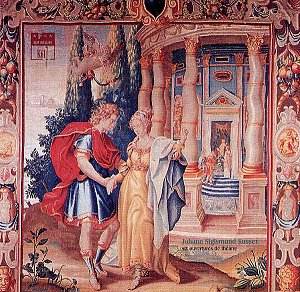|
|
Search MusicWeb Here |
|
 |
||
|
Founder:
Len Mullenger (1942-2025) Editor
in Chief:John Quinn
|
|
|
Search MusicWeb Here |
|
 |
||
|
Founder:
Len Mullenger (1942-2025) Editor
in Chief:John Quinn
|
 |
Johann Sigismund KUSSER
(Cousser) (1660-1724)
|
| CD available for post-free online mail-order or you may download individual tracks. For some labels you can download the entire CD with a single click and make HUGE savings. The price you see is the price you pay! The full booklet notes are available on-line. | |
|
NOTE • Click on the button and you can buy the disc or read the booklet details • You can also access each track which you may then sample or down load. • Further Information. |
|
|
This is a specialist CD focusing on lesser known baroque works performed by members of the above ensemble and orchestra.
Johann Kusser was born in Bratislava of Hungarian parentage and a musician father who was choirmaster in Stuttgart. It is believed that the young Kusser spent some time in Paris with Lully where he became conversant with the French style of composition. (In Stuttgart, Kusser spelt his name as Cousser.)
Kusser's music is representative of the Second Baroque movement which came into being around 1670 and embraced a pot-pourri of French, German and Italian styles. He deliberately set out to follow the style of Baptiste in his early works and told the Duke of Wurtemberg (his employer) so in a dedication to him.
In the 1670s French Court Ballet was at the height of fashion in Europe and the courts in the principal countries were apparently caught up by the craze. Kusser later moved to Germany to direct the opera at Hamburg and then moved on to Nuremberg and eventually returned to Stuttgart. When offered a cathedral post he finally moved to Ireland where he died.
As an historic document this recording is welcome. Kusser was not the Bach of his day and perhaps there is a pedantry in some of these ouvertures. The overtures contain a series of dances such as bourrée, gigue, minuet, gavotte which are not indexed. (A four second spacer is provided.) The music is sensitively played on authentic instruments and is tastefully presented but I would have welcomed wider changes in dynamics. The acoustics are fitting and well suited to court music. The harpsichord could have been brought forward a little to good effect.
The notes in French, English, and German are unusually set out and somewhat difficult to follow. One would have wished for a more 'ordinaire' style of layout. The light-faced font is not easy on the eye and one has to sift to find the required detail. The notes tell us he died in 1724 yet the outer disc box tells us differently and that he died in 1727. There are no notes describing the pieces themselves.
|
|
Return to Index |